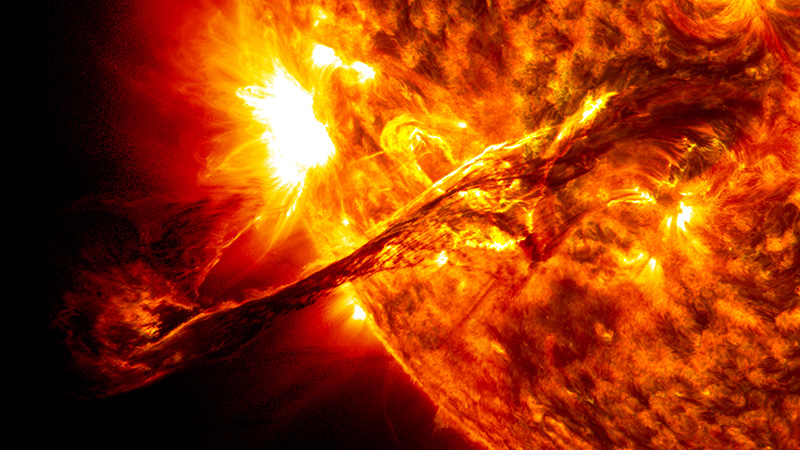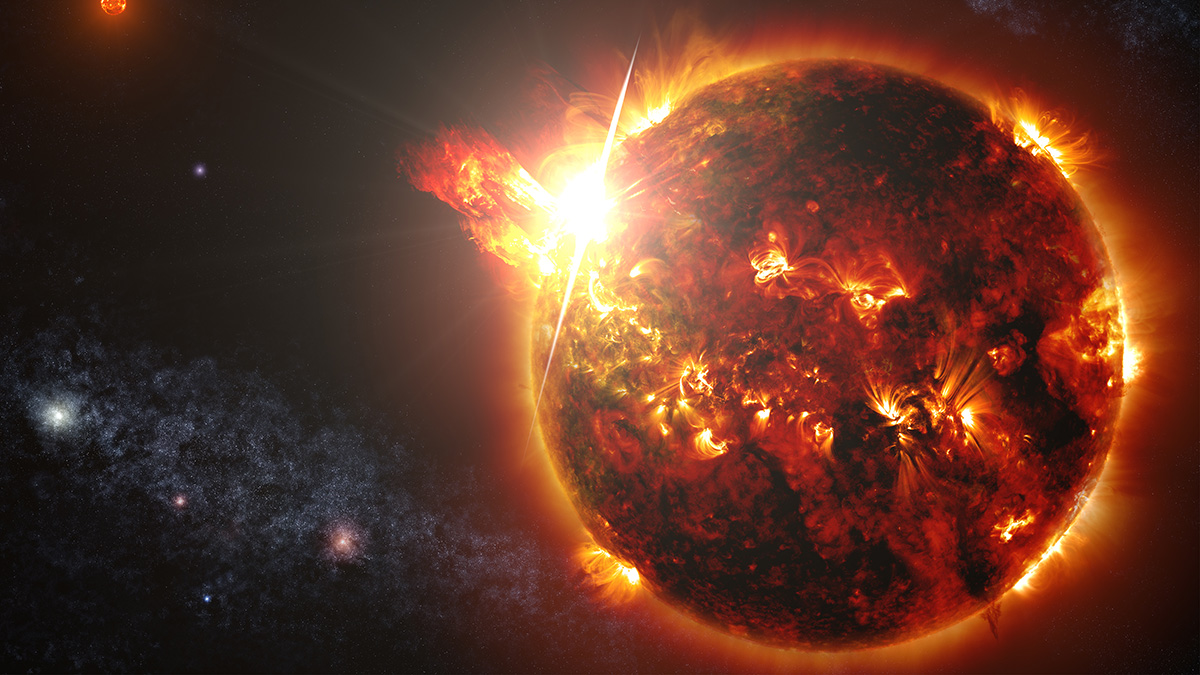You could be forgiven for missing what comes after a coronal mass ejection (CME). Colossal outbursts of plasma hurtling into space at hundreds to thousands of kilometers per second, CMEs are a spectacle. Scientists have observed many CMEs from our Sun since the 1970s.
But researchers are now turning their gaze away from a CME’s jettison to what’s been lost. After a CME, extreme ultraviolet light in the corona dims noticeably at the ejection site. Finding darkened spots could hold a key to observing elusive stellar CMEs.
New research using coronal dimming to identify CME candidates in stars found 21 occurrences of coronal dimmings in 13 different stars.
Before this research, scientists could “probably count ‘convincing detections’ with our hands,” said astrophysicist Julián David Alvarado-Gómez at the Leibniz Institute for Astrophysics Potsdam, who was not involved in the work. “And some scientists would probably remain skeptical about some of them.”
Pinpointing stellar CMEs could be important for finding habitable exoplanets. Stellar flares could “totally blow away the atmosphere of an exoplanet,” said Astrid Veronig, the lead researcher of the latest work and chair of Solar and Heliospheric Physics at the Institute of Physics at the University of Graz in Austria.
Coronal Dimming
Over the past 3 decades, researchers have detected evidence of stellar CMEs from M-class stars. And in a 2019 paper in Nature Astronomy, Costanza Argiroffi published a detailed account of a monstrous CME from a star 450 light-years from Earth.
Veronig and her colleagues took a different approach: coronal dimming.
If these dimmings indicate CMEs, it is the largest number of stellar CMEs detections reported.
Coronal dimmings are lower-density regions in a star’s corona that occur after those areas are depleted of plasma following a CME. If these dimmings indicate CMEs, the latest work represents the largest number of stellar CME detections reported.
Veronig found certain stars that dimmed more than once, like the rapidly rotating AB Dor with five events, the young AU Mic with three events, and the nearby Proxima Centauri with two events.
“Proxima Centauri is the most interesting because it’s our closest star and it’s known to have exoplanets,” said Veronig, who published the work in Nature Astronomy last year.
Sun as Star

To start, the researchers first considered coronal dimming on our Sun. Looking at the Sun as if it were a far-off star, they analyzed the extreme ultraviolet light curves from instruments on NASA’s Solar Dynamics Observatory (SDO). They compared fluctuations in the light curve with images of CMEs and coronal dimmings caught by spatially resolved instruments on SDO.
The team found that CMEs from the Sun precede coronal dimmings that decrease broadband extreme ultraviolet emissions by a few percent. The probability that the signature they observed was related to a CME was 95%.
Next, Veronig and her team looked for stellar dimmings. Combing through historical extreme ultraviolet data collected by the Extreme Ultraviolet Explorer from NASA, as well as soft X-ray wavelengths from ESA’s X-ray Multi-Mirror Mission and NASA’s Chandra X-ray Observatory, they found about 200 star candidates.
“Now we’ve shown it is possible, can [scientists] go further and extract more information from it?”
The stars had to be Sun-like, known to flare, and measured for long enough periods (e.g., 10 hours) to qualify.
Unlike solar dimming of a few percent, stellar dimming decreased emissions by up to 56%. Stellar light curves are noisier than the Sun’s, so only big events came through.
“Now we’ve shown it is possible, can [scientists] go further and extract more information from it?” Veronig said of the new technique. Satellite missions planned by NASA, like the proposed Extreme-ultraviolet Stellar Characterization for Atmospheric Physics and Evolution (ESCAPE) mission, would make spotting stellar coronal dimmings easier.
Building Momentum
Alvarado-Gómez called the work a “crucial contribution” to understanding space weather around other stars but worried about an underlying assumption that other stars will behave like our Sun. “Dimmings alone are not sufficient to unequivocally find a CME event.”
Assistant professor in physics and applied physics Ofer Cohen from the University of Massachusetts Lowell called the technique promising but warned that detecting coronal dimmings can’t tell us about a CME’s characteristics or spatial position on the stellar disk. Cohen did not participate in the research.
The results support a simulation paper by Meng Jin at the SETI Institute and the Lockheed Martin Solar and Astrophysics Laboratory. Digging deeper into these promising findings from the latest paper and advancing modeling, said Jin, “will provide a critical reference for further instrumentation and methodology to better detect stellar CMEs that significantly influence the habitability of explanatory systems.”
—Jenessa Duncombe (@jrdscience), Staff Writer
7 June 2022: The article has been updated to correct the stellar dimming emission percentages.


